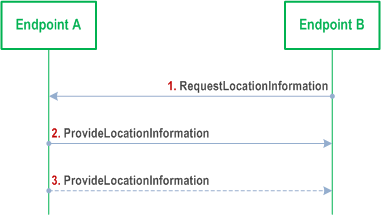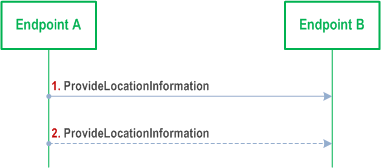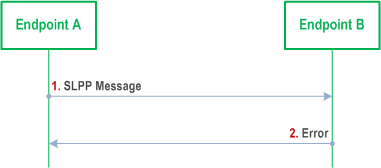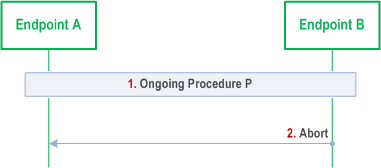Content for TS 38.355 Word version: 18.0.0
5.3 Procedures related to Location Information Transfer
5.3.1 General
5.3.2 Location Information Transfer procedure
5.3.3 Location Information Delivery procedure
5.3.4 Transmission of Request Location Information
5.3.5 Reception of Request Location Information
5.3.6 Transmission of Provide Location Information
5.4 Error Handling Procedures
5.4.1 General
5.4.2 Procedures related to Error Indication
5.4.3 SLPP Error Detection
5.4.4 Reception of an SLPP Error Message
5.5 Abort Procedure
5.5.1 General
5.5.2 Procedures related to Abort
5.5.3 Reception of an SLPP Abort Message
5.3 Procedures related to Location Information Transfer p. 17
5.3.1 General p. 17
The purpose of the procedures that are grouped together in this clause is to enable Endpoint B to request location measurement data and/or a location estimate from Endpoint A, and to enable Endpoint A to transfer location measurement data and/or a location estimate to Endpoint B in the absence of a request.
5.3.2 Location Information Transfer procedure p. 17
The Location Information Transfer procedure is shown in Figure 5.3.2-1.

Step 1.
Endpoint B sends a RequestLocationInformation message to Endpoint A to request location information, indicating the type of location information needed and potentially the associated QoS.
Step 2.
Endpoint A sends a ProvideLocationInformation message to Endpoint B to transfer location information. The location information transferred should match or be a subset of the location information requested in step 1 unless Endpoint B explicitly allows additional location information. If step 3 does not occur, this message shall set the endTransaction IE to TRUE.
Step 3.
If requested in step 1, Endpoint A sends additional ProvideLocationInformation messages to Endpoint B to transfer location information. The location information transferred should match or be a subset of the location information requested in step 1 unless Endpoint B explicitly allows additional location information. The last message shall include the endTransaction IE set to TRUE.
5.3.3 Location Information Delivery procedure p. 17
The Location Information Delivery procedure allows Endpoint A to provide unsolicited location information to Endpoint B. The procedure is shown in Figure 5.3.3-1.

Step 1.
Endpoint A sends a ProvideLocationInformation message to Endpoint B to transfer location information. If step 2 does not occur, this message shall set the endTransaction IE to TRUE.
Step 2.
Endpoint A may send one or more additional ProvideLocationInformation messages to Endpoint B containing additional location information data. The last message shall include the endTransaction IE set to TRUE.
5.3.4 Transmission of Request Location Information p. 18
When triggered to transmit a RequestLocationInformation message, Endpoint B shall:
1 >
set the method specific RequestLocationInformation IEs in accordance with the information received from upper layers.
1 >
deliver the message to lower layers for transmission.
5.3.5 Reception of Request Location Information p. 18
Upon receiving a RequestLocationInformation message, Endpoint A shall:
1 >
if the requested information is compatible with Endpoint A's capabilities and configuration:
2 >
1 >
include the requested information in a ProvideLocationInformation message;
2 >
set the SessionID IE in the response message to the same value as the SessionID IE in the received message if received;
2 >
set the SLPP-TransactionID IE in the response to the same value as the SLPP-TransactionID IE in the received message;
2 >
deliver the ProvideLocationInformation message to lower layers for transmission.
otherwise:
2 >
if one or more positioning methods are included that Endpoint A does not support:
3 >
continue to process the message as if it contained only information for the supported positioning methods;
3 >
handle the signaling content of the unsupported positioning methods by SLPP error detection as in clause 5.4.3.
5.3.6 Transmission of Provide Location Information p. 18
When triggered to transmit ProvideLocationInformation message, Endpoint A shall:
1 >
for each positioning method contained in the message:
2 >
1 >
set the corresponding IE to include the available location information;
deliver the response to lower layers for transmission.
5.4 Error Handling Procedures p. 19
5.4.1 General p. 19
This clause describes how a receiving entity behaves in cases when it receives erroneous or unexpected data or detects that certain data are missing.
5.4.2 Procedures related to Error Indication p. 19
Figure 5.4.2-1 shows the Error indication procedure.

Step 1.
Endpoint A sends an SLPP message to Endpoint B.
Step 2.
Endpoint B determines that the SLPP message in step 1 contains an error. Endpoint B returns an Error message to Endpoint A indicating the error or errors and discards the message in step 1. If Endpoint B is able to determine that the erroneous SLPP message in step 1 is an SLPP Error or Abort Message, Endpoint B discards the message in step 1 without returning an Error message to Endpoint A.
5.4.3 SLPP Error Detection p. 19
Upon receiving any SLPP message, the receiving entity shall attempt to decode the message and verify the presence of any errors and:
1 >
if decoding errors are encountered:
2 >
1 >
if the receiver cannot determine that the received message is an SLPP Error or Abort message:
3 >
return an SLPP Error message to the sender and include the SessionID (if PC5-U is used as transport layer) and the received SLPP-TransactionID, if they were decoded, and type of error;
3 >
discard the received message and stop the error detection procedure;
if the message is a duplicate of a previously received message:
2 >
1 >
discard the message and stop the error detection procedure;
if the SLPP-TransactionID matches the SLPP-TransactionID for a procedure that is still ongoing for the same session and the message type is invalid for the current state of the procedure:
2 >
1 >
abort the ongoing procedure;
2 >
return an SLPP Error message to the sender and include the SessionID (if PC5-U is used as transport layer), the received transaction ID and type of error;
2 >
discard the message and stop the error detection procedure;
if the message type is an SLPP RequestCapabilities and some of the requested information is not supported:
2 >
1 >
return any information that can be provided in a normal response.
if the message type is an SLPP RequestAssistanceData or RequestLocationInformation and some or all of the requested information is not supported:
2 >
return any information that can be provided in a normal response, which includes indications on other information that is not supported.
5.4.4 Reception of an SLPP Error Message p. 20
Upon receiving an Error message, Endpoint shall:
1 >
Endpoint may:
abort any ongoing procedure associated with the SessionID and the SLPP-TransactionID if included in the received message.
1 >
restart the aborted procedure taking into consideration the returned error information.
5.5 Abort Procedure p. 20
5.5.1 General p. 20
The purpose of the abort procedure is to allow Endpoints to abort an ongoing procedure due to some unexpected event (e.g., cancellation of a location request by an LCS client). It can also be used to stop an ongoing procedure (e.g., periodic location reporting from an Endpoint).
5.5.2 Procedures related to Abort p. 20
Figure 5.5.2-1 shows the Abort procedure.

Step 1.
A procedure P is ongoing between endpoints A and B.
Step 2.
Endpoint A determines that the procedure must be aborted and sends an Abort message to Endpoint B carrying the SessionID (if PC5-U is used as transport layer) and the SLPP-TransactionID for procedure P. Endpoint B aborts procedure P.
5.5.3 Reception of an SLPP Abort Message p. 20
Upon receiving an Abort message, Endpoint shall:
1 >
abort any ongoing procedure associated with the SessionID and the SLPP-TransactionID indicated in the message.